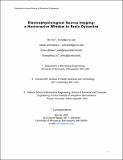| dc.contributor.author | He, Bin | |
| dc.contributor.author | Sohrabpour, Abbas | |
| dc.contributor.author | Brown, Emery Neal | |
| dc.contributor.author | Liu, Zhongming | |
| dc.date.accessioned | 2019-12-17T21:52:26Z | |
| dc.date.available | 2019-12-17T21:52:26Z | |
| dc.date.issued | 2018-06 | |
| dc.identifier.issn | 1523-9829 | |
| dc.identifier.issn | 1545-4274 | |
| dc.identifier.uri | https://hdl.handle.net/1721.1/123301 | |
| dc.description.abstract | Brain activity and connectivity are distributed in the three-dimensional space and evolve in time. It is important to image brain dynamics with high spatial and temporal resolution. Electroencephalography (EEG) and magnetoencephalography (MEG) are noninvasive measurements associated with complex neural activations and interactions that encode brain functions. Electrophysiological source imaging estimates the underlying brain electrical sources from EEG and MEG measurements. It offers increasingly improved spatial resolution and intrinsically high temporal resolution for imaging large-scale brain activity and connectivity on a wide range of timescales. Integration of electrophysiological source imaging and functional magnetic resonance imaging could further enhance spatiotemporal resolution and specificity to an extent that is not attainable with either technique alone. We review methodological developments in electrophysiological source imaging over the past three decades and envision its future advancement into a powerful functional neuroimaging technology for basic and clinical neuroscience applications. Keywords: electrophysiological source imaging; EEG; MEG; source localization; functional connectivity; inverse problem | en_US |
| dc.description.sponsorship | National Institutes of Health (U.S.) (Grant EB021027) | en_US |
| dc.description.sponsorship | National Institutes of Health (U.S.) (Grant NS096761) | en_US |
| dc.description.sponsorship | National Institutes of Health (U.S.) (Grant MH114233) | en_US |
| dc.description.sponsorship | National Institutes of Health (U.S.) (Grant AT009263) | en_US |
| dc.description.sponsorship | National Institutes of Health (U.S.) (Grant EY023101) | en_US |
| dc.description.sponsorship | National Institutes of Health (U.S.) (Grant MH104402) | en_US |
| dc.description.sponsorship | National Institutes of Health (U.S.) (Grant EB008389) | en_US |
| dc.description.sponsorship | National Institutes of Health (U.S.) (Grant HL117664) | en_US |
| dc.description.sponsorship | National Science Foundation (Grant CBET-1450956) | en_US |
| dc.description.sponsorship | National Science Foundation (Grant DGE-1069104) | en_US |
| dc.publisher | Annual Reviews | en_US |
| dc.relation.isversionof | http://dx.doi.org/10.1146/annurev-bioeng-062117-120853 | en_US |
| dc.rights | Creative Commons Attribution-Noncommercial-Share Alike | en_US |
| dc.rights.uri | http://creativecommons.org/licenses/by-nc-sa/4.0/ | en_US |
| dc.source | Prof. Brown via Courtney Crummett | en_US |
| dc.title | Electrophysiological Source Imaging: A Noninvasive Window to Brain Dynamics | en_US |
| dc.type | Article | en_US |
| dc.identifier.citation | He, Bin et al. "Electrophysiological Source Imaging: A Noninvasive Window to Brain Dynamics." Annual Review of Biomedical Engineering 20 (June 2018): 171-196. © 2018 Annual Reviews | en_US |
| dc.contributor.department | Harvard University--MIT Division of Health Sciences and Technology | en_US |
| dc.relation.journal | Annual Review of Biomedical Engineering | en_US |
| dc.eprint.version | Author's final manuscript | en_US |
| dc.type.uri | http://purl.org/eprint/type/JournalArticle | en_US |
| eprint.status | http://purl.org/eprint/status/PeerReviewed | en_US |
| dspace.date.submission | 2019-12-05T17:39:20Z | |
| mit.journal.volume | 20 | en_US |
| mit.journal.issue | 1 | en_US |
